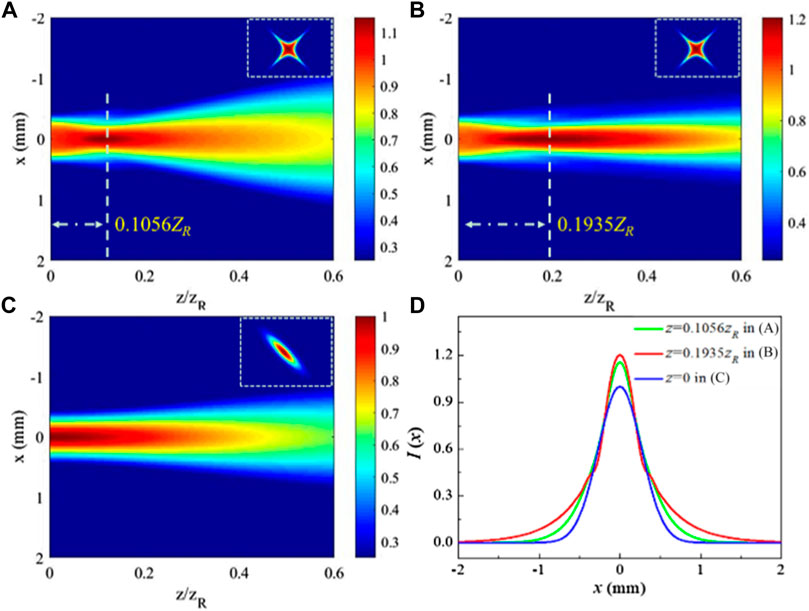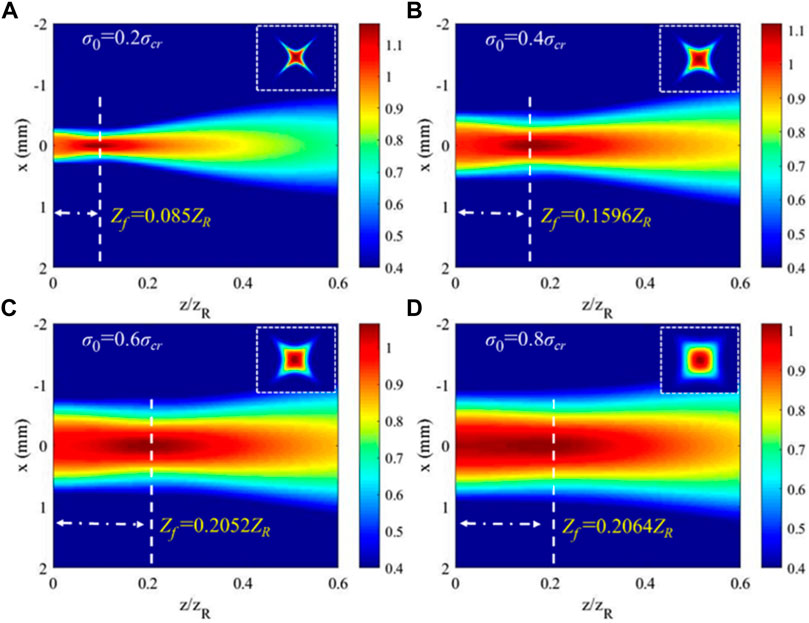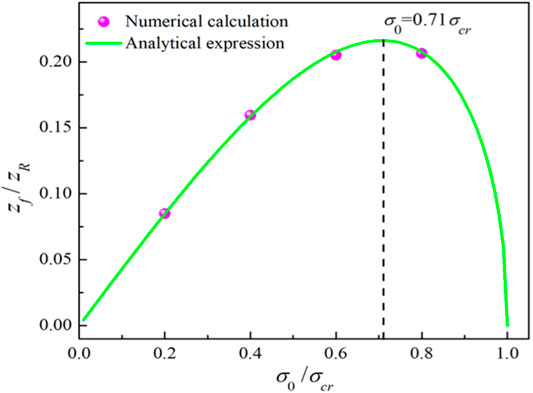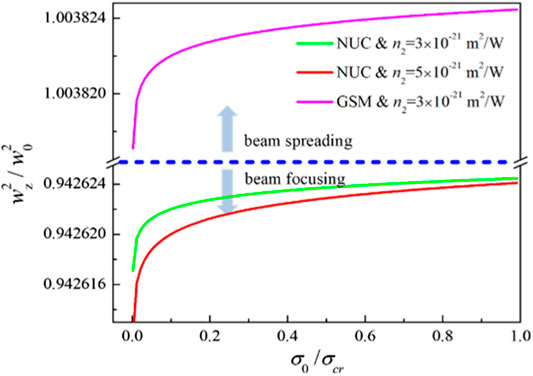- 1Jiangsu Key Lab of Opto-Electronic Technology, School of Physics and Technology, Nanjing Normal University, Nanjing, China
- 2National Astronomical Observatories/Nanjing Institute of Astronomical Optics and Technology, Chinese Academy of Sciences, Nanjing, China
- 3CAS Key Laboratory of Astronomical Optics and Technology, Nanjing Institute of Astronomical Optics and Technology, Nanjing, China
- 4Shandong Provincial Engineering and Technical Center of Light Manipulations & Shandong Provincial Key Laboratory of Optics and Photonic Device, School of Physics and Electronics, Shandong Normal University, Jinan, China
- 5Key Laboratory of Atmospheric Optics, Anhui Institute of Optics and Fine Mechanics, Chinese Academy of Sciences, Hefei, China
- 6College of Physics and Electronic Engineering, Heze University, Heze, China
- 7School of Physical Science and Technology, Soochow University, Suzhou, China
Coherence in a light beam has the potential to serve as a degree of freedom for manipulating the beam. In this work, the self-focusing property of a partially coherent beam with a non-uniform correlation structure propagating in a non-linear medium is investigated. The analysis of the evolution of beam width reveals that the coherence structure plays a vital role in the self-focusing formation. A threshold condition for the coherence radius is proposed for the first time, and the relation of self-focusing length and initial coherence radius is studied numerically and analytically. It is shown that a feasible approach for manipulating the self-focusing length by adjusting the initial coherence radius is achieved.
Introduction
Spatial coherence is a crucial intrinsic characteristic of light. Optical coherence is now the subject of a well-developed theory [1]; the laser beam with decreased spatial coherence has been analyzed in depth, and it has been labeled as the partially coherent beam (PCB) [2]. By adjusting the spatial coherence of PCBs, novel properties can be exhibited that play a significant role in the light–matter interaction and have attracted the attention of researchers [1, 3]. In the past few decades, intense interest has been focused on the design of different types of PCBs and the interaction between PCBs and various media. To date, many PCBs with uniform or non-uniform correlation structures have been introduced [4], and their propagation properties in turbulence and uniaxial crystal media have been studied [5, 6]. Although these works have been extensive and might seem to be complete, the investigations have not exhausted all possibilities. The non-linear effect can significantly affect the essence of PCB propagation; in practical terms, the Kerr effect strongly exists when an intense laser beam is present in non-linear media.
There are several approaches to describe the propagation of PCBs in a non-linear medium, for example, the coherent density approach [7], multimode decomposition [8], the geometric optics approach [9], and the mutual coherence function [1]. At present, the Gaussian–Schell source model (GSM) of a partially coherent beam propagating in a non-linear medium is frequently used [10–14]. With a spatially variant correlation function proposed by Gori et al. [15], PCBs with a non-uniform correlation structure not only exhibit self-focusing and self-shifting properties [16–19] but also produce lower scintillation in turbulence [20, 21] than that of GSM beams. The self-focusing property of non-uniformly correlated PCBs (NUC-PCBs) may spark extensive interest owing to their wide application in many fields, such as laser filamentation [10], lightening control [22], high-power atmospheric propagation [23], optical micromanipulation [24], optical communications [25], and optical coherence encryption [26]. Thus, the investigation of the self-focusing property of NUC-PCBs has potential application prospects.
Spatial coherence is regarded as a significant element of a laser beam, and it is vital to achieve the manipulation of self-focusing domain, especially for the control of filamentation one. Until now, the well-known methods for controlling the filamentation domain are as follows: modulating the laser pulse power [27], adjusting the divergence angle of initial laser [28], launching negatively chirped ultrashort pulses [29], and double-lens setup [23]. It is worth mentioning that the input peak intensity is the easiest quantity to change and control precisely [30]; however, the laser power is still limited in the practical scene. If the spatial coherence can be used to control the self-focusing length, it may provide an alternative route to realize the manipulation of filamentation domain. It not only fills in the gap of spatial coherence to control the length of self-focusing but also proposes a feasible solution to obtain the long-range filament propagation. Therefore, it is time to explore an avenue for achieving the manipulation of self-focusing length by adjusting the coherence.
In this work, the self-focusing property of an NUC-PCB propagating in a non-linear medium is investigated. Combining with the non-linear Schrödinger (NLS) equation and mutual coherence function, an analytical expression for beam width is derived. By analyzing the evolution of beam width, the result illustrates that the coherence structure is a key element for self-focusing formation. Furthermore, with the first proposal of the threshold condition of coherence radius, the analytical formula of self-focusing length is obtained. More importantly, it is found that a feasible approach for manipulating the self-focusing length by adjusting the initial coherence radius is realized. These new findings may provide a theoretical and numerical basis in optical communication, optical encryption, optical micro-fabrication, and related areas.
Theory
The propagation dynamics of laser beams in a Kerr medium is described by the NLS equation. Under the slowly varying amplitude approximation, the NLS equation for a two-dimensional quasi-monochromatic partially coherent beam is [10]
where
Using a PCB as the laser source, Eq. 1 is unable to correctly describe the propagation evolution in a non-linear medium. Spatial coherence refers to the correlation of complex fields at the same time but at different transverse points
Mutual coherence function, i.e.,
Considering the PCB with non-uniform correlation function, i.e., assuming Gaussian weight and kernel functions in the spatial domain, the mutual coherence function at the source plane is [17, 18]
with the initial coherence radius
By setting
where
Inserting initial conditions (beam width
Combining Eqs. 6, 8, the dynamics of beam width of an NUC-PCB is
with the boundary condition
To ensure the NUC-PCB with a minimum beam width (without collapse), the first and second derivatives of beam width should satisfy the following requirements:
Based on Eq. 12, the critical coherence radius for the formation of self-focusing is given by
Here, the initial coherence radius should be considered as
With boundary conditions
Physically, the evolution of beam width is determined by a competition for two main factors: 1) spreading induced by free-space diffraction and 2) self-focusing caused by the non-uniform correlation structure and non-linearity of the medium. Here, the parameters are recorded as
When the critical coherence radius is satisfied, the self-focusing length can be expressed as
where a variable substitution is used, due to the common range of variables
Numerical Calculations and Analysis
Using the fast Fourier transform split-step method [35], the initial parameters are chosen as follows: wavelength
The self-focusing length for the NUC-PCB in the linear and non-linear media is investigated numerically, where the non-linear refractive index is

FIGURE 1. Propagation evolution of three cases: (A) NUC-PCB in a linear medium, (B) NUC-PCB in a non-linear medium, and (C) GSM beam in a non-linear medium, where (D) shows the corresponding intensity distribution at the locations of maximum intensity in (A–C). The insets represent the mutual coherence function (or cross-spectral density) at the source plane.
For the analytical expression of beam width (i.e., Eq. 14), it is obvious that the propagation dynamics are determined by a balance of three elements, i.e., diffraction (or dispersion), coherence structure of beam, and property of propagation medium. Similarly, the beam width for the GSM beam is derived as
Based on the analysis of the beam width’s dependence on the coherence structure, it appears that the initial coherence radius can be regarded as a degree of freedom for manipulating the self-focusing length. To verify this hypothesis, the numerical and analytical methods were successively used. In the numerical calculation, the initial coherence radii are selected as follows:

FIGURE 3. Self-focusing length with various initial coherence radii: (A)

FIGURE 4. Dependence of the relative self-focusing length on the initial coherence radius. The magenta dots correspond to the cases in Figure 3.
Conclusion and Discussions
In summary, the self-focusing property of a partially coherent beam with a non-uniform correlation structure propagating in a non-linear medium was investigated using numerical and analytical methods. It is found that the non-uniform correlation structure plays a core role in the self-focusing formation. Furthermore, with the threshold condition of initial coherence radius proposed for the first time, the analytical formula for the self-focusing length is obtained. The result shows that the relation of relative self-focusing length and initial coherence radius is not monotonic, and it can be continuously controlled by changing the initial coherence radius. More significantly, a feasible approach for manipulating the self-focusing length by adjusting the initial coherence radius has been realized. These findings may have potential applications in optical communication, optical encryption, all-optical signal processing, and related areas. For example, it is known that the polarization [36–38] and orbital angular momentum [39] can be used as a carrier basis of signals for optical communication links. Herein, spatial coherence is regarded as the degree of freedom of a light beam as well, and it may provide another dimension for data-coding. In addition, the self-focusing length can be manipulated by varying the initial coherence radius of NUC-PCBs, benefiting for a controllable high-power laser atmospheric propagation for moving targets.
Data Availability Statement
The original contributions presented in the study are included in the article, and further inquiries can be directed to the corresponding authors.
Author Contributions
All authors listed have made a substantial, direct, and intellectual contribution to the work and approved it for publication.
Funding
We acknowledge the National Key Research and Development Project of China (2019YFA0705000), National Natural Science Foundation of China (91750201, 11974218, 11804234, 11903062, 12192254, and 11904087), Innovation Group of Jinan (2018GXRC010), and Local Science and Technology Development Project of the Central Government (YDZX20203700001766). We appreciate the valuable comments from reviewers.
Conflict of Interest
The authors declare that the research was conducted in the absence of any commercial or financial relationships that could be construed as a potential conflict of interest.
Publisher’s Note
All claims expressed in this article are solely those of the authors and do not necessarily represent those of their affiliated organizations, or those of the publisher, the editors, and the reviewers. Any product that may be evaluated in this article, or claim that may be made by its manufacturer, is not guaranteed or endorsed by the publisher.
References
1. Mandel L, Wolf E. Optical Coherence and Quantum Optics. Cambridge, UK: Cambridge University Press (1995).
2. Cai Y, Chen Y, Yu J, Liu X, Liu L. Generation of Partially Coherent Beams. Prog Opt (2017) 62:157–223. doi:10.1016/bs.po.2016.11.001
3. Chen Y, Norrman A, Ponomarenko SA, Friberg AT. Optical Coherence and Electromagnetic Surface Waves. Prog Opt (2020) 65:105–72. doi:10.1016/bs.po.2019.11.001
4. Cai Y, Chen Y, Wang F. Generation and Propagation of Partially Coherent Beams with Nonconventional Correlation Functions: a Review [Invited]. J Opt Soc Am A (2014) 31(9):2083–96. doi:10.1364/josaa.31.002083
5. Gbur G. Partially Coherent Beam Propagation in Atmospheric Turbulence [Invited]. J Opt Soc Am A (2014) 31(9):2038–45. doi:10.1364/josaa.31.002038
6. Lin R, Chen M, Liu Y, Zhang H, Gbur G, Cai Y, et al. Measuring Refractive Indices of a Uniaxial crystal by Structured Light with Non-uniform Correlation. Opt Lett (2021) 46(10):2268–71. doi:10.1364/ol.424259
7. Christodoulides DN, Coskun TH, Mitchell M, Segev M. Theory of Incoherent Self-Focusing in Biased Photorefractive Media. Phys Rev Lett (1997) 78:646–9. doi:10.1103/physrevlett.78.646
8. Christodoulides DN, Coskun TH, Mitchell M, Segev M. Multimode Incoherent Spatial Solitons in Logarithmically Saturable Nonlinear Media. Phys Rev Lett (1998) 80:2310–3. doi:10.1103/physrevlett.80.2310
9. Snyder AW, Mitchell DJ. Big Incoherent Solitons. Phys Rev Lett (1998) 80:1422–4. doi:10.1103/physrevlett.80.1422
10. Królikowski W, Edmundson D, Bang O. Unified Model for Partially Coherent Solitons in Logarithmically Nonlinear media. Phys Rev E (2000) 61:3122–6. doi:10.1103/physreve.61.3122
11. Mendonça JT, Tsintsadze NL. Analog of the Wigner-Moyal Equation for the Electromagnetic Field. Phys Rev E (2000) 62:4276–82. doi:10.1103/physreve.62.4276
12. Nayyar VP. Propagation of Partially Coherent Gaussian Schell-Model Sources in Nonlinear media. J Opt Soc Am B (1997) 14(9):2248–53. doi:10.1364/josab.14.002248
13. Wang H, Ji X-L, Zhang H, Li X-Q, Deng Y. Propagation Formulae and Characteristics of Partially Coherent Laser Beams in Nonlinear media. Opt Lett (2019) 44(4):743–6. doi:10.1364/ol.44.000743
14. Wang H, Ji X-L, Deng Y, Li X-Q, Yu H. Theory of the Quasi-Steady-State Self-Focusing of Partially Coherent Light Pulses in Nonlinear media. Opt Lett (2020) 45(3):710–3. doi:10.1364/ol.379902
15. Gori F, Santarsiero M. Devising Genuine Spatial Correlation Functions. Opt Lett (2007) 32(24):3531–3. doi:10.1364/ol.32.003531
16. Lajunen H, Saastamoinen T. Propagation Characteristics of Partially Coherent Beams with Spatially Varying Correlations. Opt Lett (2011) 36(20):4104–6. doi:10.1364/ol.36.004104
17. Tong Z, Korotkova O. Nonuniformly Correlated Light Beams in Uniformly Correlated media. Opt Lett (2012) 37(15):3240–2. doi:10.1364/ol.37.003240
18. Lajunen H, Saastamoinen T. Non-uniformly Correlated Partially Coherent Pulses. Opt Express (2013) 21(1):190–5. doi:10.1364/oe.21.000190
19. Yu J, Cai Y, Gbur G. Rectangular Hermite Non-uniformly Correlated Beams and its Propagation Properties. Opt Express (2018) 26(21):27894–906. doi:10.1364/oe.26.027894
20. Yu J, Wang F, Liu L, Cai Y, Gbur G. Propagation Properties of Hermite Non-uniformly Correlated Beams in Turbulence. Opt Express (2018) 26(13):16333–43. doi:10.1364/oe.26.016333
21. Gu Y, Gbur G. Scintillation of Nonuniformly Correlated Beams in Atmospheric Turbulence. Opt Lett (2013) 38(9):1395–7. doi:10.1364/ol.38.001395
22. Houard A, D’Amico C, Liu Y, Andre YB, Franco M, Prade B, et al. High Current Permanent Discharges in Air Induced by Femtosecond Laser Filamentation. Appl Phys Lett (2007) 90:171501. doi:10.1063/1.2734396
23. Fibich G, Sivan Y, Ehrlich Y, Louzon E, Fraenkel M, Eisenmann S, et al. Control of the Collapse Distance in Atmospheric Propagation. Opt Express (2006) 14(12):4946–57. doi:10.1364/oe.14.004946
24. Zhao C, Cai Y, Lu X, Eyyuboğlu HT. Radiation Force of Coherent and Partially Coherent Flat-Topped Beams on a Rayleigh Particle. Opt Express (2009) 17(3):1753–65. doi:10.1364/oe.17.001753
25. Yu J, Zhu X, Lin S, Wang F, Gbur G, Cai Y. Vector Partially Coherent Beams with Prescribed Non-uniform Correlation Structure. Opt Lett (2020) 45(13):3824–7. doi:10.1364/ol.397316
26. Peng D, Huang Z, Liu Y, Chen Y, Wang F, Ponomarenko SA, et al. Optical Coherence Encryption with Structured Random Light. PhotoniX (2021) 2(1):6. doi:10.1186/s43074-021-00027-z
27. Houard A, Franco M, Prade B, Durécu A, Lombard L, Bourdon P, et al. Femtosecond Filamentation in Turbulent Air. Phys Rev A (2008) 78:033804. doi:10.1103/physreva.78.033804
28. Jin Z, Zhang J, Xu MH, Lu X, Li YT, Wang ZH, et al. Control of Filamentation Induced by Femtosecond Laser Pulses Propagating in Air. Opt Express (2005) 13(25):10424–30. doi:10.1364/opex.13.010424
29. Sprangle P, Peñano JRB, Hafizi B. Propagation of Intense Short Laser Pulses in the Atmosphere. Phys Rev E Stat Nonlin Soft Matter Phys (2002) 66:046418. doi:10.1103/PhysRevE.66.046418
30. Buryak A, Trapani PD, Skryabin DV, Trillo S. Optical Solitons Due to Quadratic Nonlinearities: from Basic Physics to Futuristic Applications. Phys Rep (2002) 370(2):63–235. doi:10.1016/s0370-1573(02)00196-5
31. Wolf E. A Macroscopic Theory of Interference and Diffraction of Light from Finite Sources II. Fields with a Spectral Range of Arbitrary Width. Proc Roy Soc (1955) A230:246.
33. Wolf E. Introduction to the Theory of Coherence and Polarization of Light. Cambridge, UK: Cambridge University Press (2007).
34. Andrews LC, Phillips RL. Laser Beam Propagation through Random Media. Bellingham: SPIE Press (2005).
35. Hermansson B, Yevick D, Friberg AT. Optical Coherence Calculations with the Split-step Fast Fourier Transform Method. Appl Opt (1986) 25(16):2645–7. doi:10.1364/ao.25.002645
36. Andrews MR, Mitra PP, deCarvalho R. Tripling the Capacity of Wireless Communications Using Electromagnetic Polarization. Nature (2001) 409(6818):316–8. doi:10.1038/35053015
37. Turpin A, Loiko Y, Kalkandjiev TK, Mompart J. Free-space Optical Polarization Demultiplexing and Multiplexing by Means of Conical Refraction. Opt Lett (2012) 37(20):4197–9. doi:10.1364/ol.37.004197
38. Lu L, Wang Z, Cai Y. Propagation Properties of Phase-Locked Radially-Polarized Vector fields Array in Turbulent Atmosphere. Opt Express (2021) 29(11):16833–44. doi:10.1364/oe.427003
Keywords: partially coherent beam, non-uniform correlation structure, optical coherence, coherence radius, self-focusing length
Citation: Lu L, Wang Z, Yu J, Qiao C, Lin R and Cai Y (2022) Self-Focusing Property of Partially Coherent Beam With Non-Uniform Correlation Structure in Non-Linear Media. Front. Phys. 9:807542. doi: 10.3389/fphy.2021.807542
Received: 02 November 2021; Accepted: 17 November 2021;
Published: 03 January 2022.
Edited by:
Xing Fu, Tsinghua University, ChinaReviewed by:
Xinzhong LI, Henan University of Science and Technology, ChinaShiyao Fu, Beijing Institute of Technology, China
Copyright © 2022 Lu, Wang, Yu, Qiao, Lin and Cai. This is an open-access article distributed under the terms of the Creative Commons Attribution License (CC BY). The use, distribution or reproduction in other forums is permitted, provided the original author(s) and the copyright owner(s) are credited and that the original publication in this journal is cited, in accordance with accepted academic practice. No use, distribution or reproduction is permitted which does not comply with these terms.
*Correspondence: Yangjian Cai, eWFuZ2ppYW5jYWlAc3VkYS5lZHUuY24=
†These authors have contributed equally to this work
 Lu Lu
Lu Lu Zhiqiang Wang
Zhiqiang Wang Jiayi Yu4
Jiayi Yu4